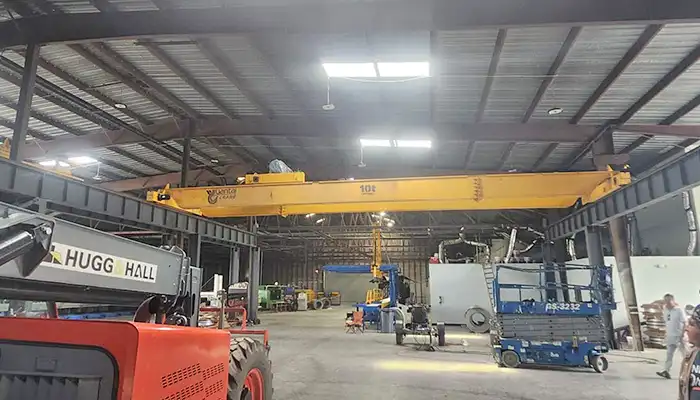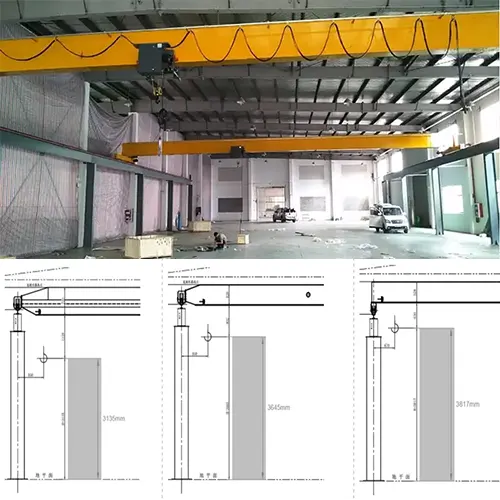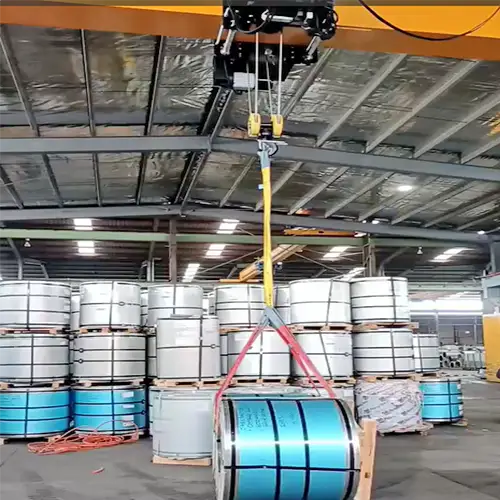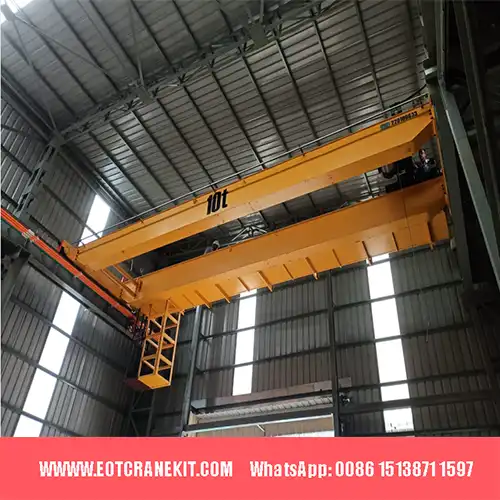Choose 10 Ton Overhead Crane for Low-Ceiling Industrial Spaces
Practical guide for selecting 10-ton overhead cranes in low-ceiling workshops, covering space limits, crane types, hoists, and operational efficiency.
Category: Featured
Your Trusted Overhead Crane Manufacturer & Supplier
Choosing the Right 10 Ton Overhead Crane for Low-Ceiling Industrial Spaces
Practical guide for selecting 10-ton overhead cranes in low-ceiling workshops, covering space limits, crane types, hoists, and operational efficiency.
Introduction
Overhead cranes play a critical role in industrial operations. From moving heavy machinery to transporting raw materials across the workshop floor, a reliable crane can save time, reduce labor costs, and improve overall workflow. In many factories, especially in metal fabrication, manufacturing, or maintenance workshops, a 10-ton overhead crane is often the ideal choice for handling medium-to-heavy loads safely and efficiently.
However, not all industrial spaces are built the same. Low-ceiling workshops present unique challenges. Limited headroom can restrict the type of crane you can install, reduce lifting height, and complicate the movement of bulky loads. If a crane is too tall or poorly chosen, it can interfere with lighting, piping, or other overhead equipment, making operations less safe and efficient.
This guide is designed to help buyers make informed decisions when selecting a 10-ton overhead crane for low-ceiling spaces. It focuses on practical considerations, from crane types and hoist options to installation and maintenance, so you can choose a solution that fits your workshop without wasting time or money.
Key points covered in this guide:
- Understanding the limitations and opportunities of low-ceiling workshops.
- Choosing the right crane type, hoist, and trolley for your space.
- Ensuring safety, efficiency, and long-term reliability.
- Planning for installation and future expansion.
Low-Ceiling Industrial Spaces
When we talk about low-ceiling industrial spaces, we mean workshops or factories where the distance from the floor to the ceiling—or to the bottom of existing structural beams—is limited. Typically, these spaces have a headroom of 6 to 9 meters (20 to 30 feet), which is lower than standard factory layouts. While this might seem tight, many operations run smoothly in these conditions with the right overhead crane setup.
Low-ceiling workshops are common in industries where the building structure was designed for light-duty work or where adding taller cranes is not feasible due to construction limitations. Common industries include:
- Manufacturing: Factories producing machinery, automotive parts, or assembly lines often need to move medium-weight components across limited vertical space.
- Maintenance Workshops: Facilities that service equipment, vehicles, or machinery frequently deal with bulky items but cannot raise the roof to accommodate standard cranes.
- Steel Fabrication and Metalworking: Cutting, welding, and handling steel plates or beams in confined spaces demands cranes that maximize lifting capacity without consuming too much headroom.
Limited headroom creates a few key challenges for crane selection:
- Reduced Lifting Height: The crane's hook travel is constrained, meaning the maximum load height is lower than in standard workshops. Careful calculation is required to ensure it can handle the tallest loads.
- Crane Type Restrictions: Certain standard overhead cranes may not fit, forcing buyers to consider underhung or low-headroom crane designs.
- Obstruction Risks: Pipes, lighting, sprinklers, and other overhead equipment can interfere with crane movement if not properly planned.
- Maintenance and Accessibility: Tighter spaces make inspections, repairs, and hoist maintenance more challenging.
Key Considerations When Choosing a 10 Ton Overhead Crane
Selecting the right 10-ton overhead crane for a low-ceiling workshop requires careful attention to several factors. Making the wrong choice can reduce lifting efficiency, create safety hazards, or even make the crane unusable. Below, we break down the key considerations in practical terms.
Headroom Requirements
In low-ceiling spaces, headroom is often the most critical limitation. Before anything else, measure the distance from the floor to the lowest obstruction above. This will determine the crane's maximum lifting height and dictate the type of crane you can install.
Practical tips for headroom planning:
- Calculate available lifting height carefully, including the hook, trolley, and any attachments.
- Maximize hook approach by choosing cranes with low-headroom hoists. This ensures the crane can lift as high as possible without hitting the ceiling.
- Always leave a small safety clearance (usually 200–300 mm) above the hook at maximum lift.
Crane Type Selection
The crane type plays a big role in efficiency and space utilization. For low-ceiling workshops, two main options are considered: underhung and top-running cranes.
Considerations include:
- Underhung vs. Top-Running: Underhung cranes attach to the bottom of the runway beams and save headroom, while top-running cranes sit on top of the rails, which may require slightly more space but allow higher load capacities.
- Single Girder vs. Double Girder: Single-girder cranes are lighter, cheaper, and fit better in low-ceiling spaces. Double-girder cranes handle heavier loads and offer greater span options but require more headroom.
- Low-Headroom Designs: Some cranes are specially engineered for tight spaces with compact trolleys and hoists, allowing maximum lifting height in limited vertical clearance.
Hoist and Trolley Options
Choosing the right hoist and trolley is crucial for safety, efficiency, and maintenance. The main types are wire rope hoists and electric chain hoists.
Key points:
- Wire Rope Hoists: Ideal for higher lifting speeds and heavier loads, but they need more vertical space.
- Electric Chain Hoists: Compact, easier to install in low-ceiling areas, and lower maintenance, though slower for heavy loads.
- Trolley Types: Low-headroom trolleys allow smooth travel under limited clearance. Consider the wheel type and track compatibility.
- Maintenance Impact: Smaller hoists in tight spaces may require more frequent checks due to constrained access, so plan for safe maintenance routes.
Load Handling and Safety
Ensuring safe handling of 10-ton loads in low-ceiling areas is non-negotiable. Even a small miscalculation can lead to serious accidents.
Important considerations:
- Weight Distribution: Ensure the load is balanced and does not exceed the crane's dynamic capacity during acceleration or travel.
- Safety Mechanisms: Limit switches, overload protection, and anti-collision devices are critical in confined spaces.
- Standards Compliance: Always check that the crane meets CE, ISO, or local safety regulations for industrial overhead lifting.
Installation and Structural Requirements
A crane is only as good as its support system. In low-ceiling workshops, the structural design must match the crane's weight, span, and operation.
Practical tips:
- Support Beam Specs: Ensure beams can handle the crane's full load plus dynamic forces. Sometimes reinforced or custom beams are needed.
- Foundation or Runway: Accurate leveling and secure anchoring of rails are essential for smooth operation.
- Space Optimization: Plan crane paths to avoid collisions with equipment, lighting, or other obstacles. Think about future adjustments or expansions.
Energy Efficiency and Operational Costs
When selecting a 10-ton overhead crane, energy use and operational costs are more important than many buyers realize. Over a crane's lifespan, power consumption and maintenance can easily add up to a significant expense. Paying attention to these factors early can save both money and headaches later.
Power Supply Compatibility
Before buying, check your workshop's electrical setup. Cranes come with specific voltage, phase, and frequency requirements, and mismatched power can lead to inefficiency or even damage.
Key points to check:
- Voltage and Phase: Ensure the crane matches your facility's supply (e.g., 380V three-phase is common in many industrial setups).
- Frequency: Most motors are designed for 50Hz or 60Hz; mismatches can reduce performance.
- Adaptability: Some modern cranes can work with variable voltage or include frequency converters, which is helpful if your power supply isn't standard.
Energy-Saving Features
Modern cranes often include features that reduce electricity use without compromising performance. These small upgrades add up over time.
Examples include:
- High-Efficiency Motors: Motors with better efficiency ratings consume less power during operation.
- Variable Frequency Drives (VFD): Allow smoother acceleration and deceleration, saving energy and reducing stress on mechanical parts.
- Smart Hoist Controls: Some systems optimize lifting and lowering cycles to reduce unnecessary power usage.
Long-Term Maintenance Costs
Energy efficiency isn't just about electricity; it's also about keeping your crane running smoothly. Poorly maintained equipment can increase energy consumption and cause downtime.
Practical tips for maintenance cost control:
- Scheduled Inspections: Regular checks of motors, brakes, and hoists prevent minor issues from turning into costly repairs.
- Lubrication and Cleaning: Keeping moving parts clean reduces friction, which saves energy and extends equipment life.
- Spare Parts Availability: Choose cranes from suppliers with easily available replacement parts; delayed repairs can drive up operational costs.
By considering power compatibility, energy-saving features, and long-term maintenance, buyers can make a 10-ton overhead crane investment that's not only safe and effective but also cost-efficient over years of operation.
Practical Tips for Buyers
Buying a 10-ton overhead crane for a low-ceiling workshop isn't just about choosing the right model—it's also about making sure you get a solution that's reliable, cost-effective, and adaptable. Here are some practical tips to guide your decision.

Evaluating Supplier Credibility and Certifications
Your crane is only as good as the company that makes it. Choosing a trustworthy supplier reduces risk and ensures you get a machine that meets both performance and safety standards.
Key points to consider:
- Certifications: Look for CE, ISO, or other recognized industrial safety and quality certifications.
- Experience: Suppliers with experience in low-ceiling crane solutions understand the space limitations and can recommend practical designs.
- Factory Visits and References: If possible, visit the manufacturer or check customer reviews to confirm reliability and build quality.
Custom vs. Standard Crane Designs
Not every workshop can fit a standard overhead crane, especially when headroom is limited. Sometimes, a custom design is the only practical option.
Considerations include:
- Low-Headroom Designs: Custom overhead cranes for low built workshops and facilities can use compact hoists, trolleys, and girder structures to maximize lifting height.
- Budget vs. Need: Standard cranes are usually cheaper and faster to deliver, while custom cranes fit your exact space and workflow but may cost more.
- Future Flexibility: Custom designs can incorporate adjustable hoist heights or wider spans to adapt to changing workshop needs.
Planning for Future Expansion or Load Changes
A well-chosen crane should not just meet today's needs—it should be flexible enough for tomorrow.
Practical tips:
- Load Growth: If your operations may increase in the future, ensure the crane can handle slightly heavier loads or longer spans without requiring a full replacement.
- Modular Add-Ons: Some cranes allow upgrades, like adding a second hoist or improving trolley speed, without major structural changes.
- Space Management: Keep a clear path for future expansions, so the crane can operate safely as your workshop layout evolves.
Conclusion
Choosing the right 10-ton overhead crane for a low-ceiling industrial workshop isn't just about picking a model off the shelf. Critical factors like headroom, crane type, hoist and trolley options, load handling, structural requirements, and operational costs all play a major role in ensuring safe and efficient operations.
It's also important to evaluate suppliers carefully, check certifications, and consider whether a custom design might better suit your space. Planning for future load increases or workshop expansions can save time and money down the line.
Consulting with experienced crane manufacturers is highly recommended. They can guide you through low-headroom solutions, recommend the best configurations, and help you maximize lifting height and workflow efficiency. With proper planning, a well-chosen 10-ton crane can boost productivity, reduce risks, and provide a strong return on investment for years to come.
Related Products

Affordable 10 ton double girder overhead crane with CD/MD hoist trolley, built for U.S. standards, ideal for construction and industrial lifting
Free consultation to Confirm Parameters & Specifications and Get
Latest Crane Price & Crane Rate.
- Types of overhead cranes : _______?
- Optional: Overhead travelling crane, goliath gantry crane,Slewing jib crane, Single girder or double girder crane,small portable crane or kbk crane, etc.
- Capacity of overhead crane: _______?
- Optional: 0.25ton, 0.5 ton, 1 ton, 2 ton, 3ton, 5 ton, 10 ton,15ton, 20ton, 25 ton, 30ton,35ton, up to 550ton, etc.
- Crane span & lifting height : _______?
- Crane travelling length : _____?
- Control of overhead crane:_______?
- Optional: pendant/ remote/cabin control
- Voltage supply of overhead crane:_____?
- Eg,: 380V50/60HZ,3Phase or others,etc.
- Application/usage of crane:_______?
- Eg,: Steel mill, ,injection mold, cement,stone, concrete,granite, general manufacturing, etc.
Just leave a message via the contact form and our hoist and crane engineer will contact you with in 24working hours.
Get In Touch





